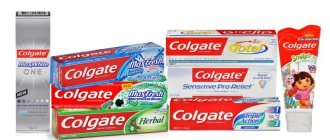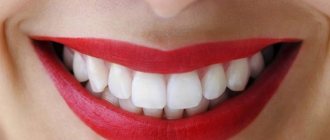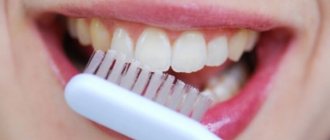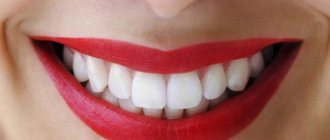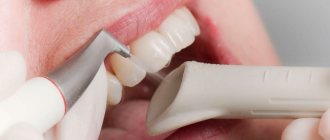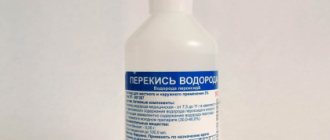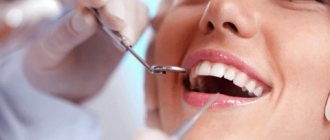How does toothpaste whiten?
Today, aesthetic dentistry divides whitening pastes into three types, which differ in the principle of their effect on the tooth surface:
Mechanical impact
All toothpastes contain various abrasives, but whitening toothpastes contain larger abrasive particles. They act on the enamel like a scrub, mechanically removing yellow surface plaque, and also intensively polish the teeth. But an increase in abrasiveness also means that there is a high probability of injury to the enamel along with the gums. Therefore, regular use of such pastes can lead to hyperesthesia - increased tooth sensitivity.
Chemical exposure
In order to achieve a whitening effect, low-percentage solutions of hydrogen peroxide or urea are added to the paste. Active enzymes of the substance interact with yellow plaque, oxidizing pigments and thereby making teeth a little lighter. In addition to peroxide, whitening toothpastes may contain chemical ingredients that lighten teeth by removing stained pellicle (a thin organic film covering tooth enamel).
Preventive effects
Often, the category of whitening pastes includes products aimed at preventing the formation of dental plaque. Various crystallization inhibitors prevent the mineralization of soft yellow plaque and tartar. Such pastes are especially relevant for smokers and coffee lovers. But it should be remembered that their use makes sense only after professional hygienic teeth cleaning in the clinic.
Clinical researches
Repeated clinical studies have proven that regular use of preventive toothpaste ASEPTA ACTIVE for a month can reduce bleeding gums by 60%, improve the overall condition of the oral cavity by 44% and reduce inflammation by 33%.
Sources:
- Report on determining/confirming the preventive properties of toothpaste “ASEPTA PLUS” GENTLE WHITENING” Author: doctor-researcher A.A. Leontyev, head Department of Preventive Dentistry, Doctor of Medical Sciences, Professor S.B. Ulitovsky First St. Petersburg State Medical University named after. acad. I.P. Pavlova, Department of Preventive Dentistry
- Clinical and laboratory assessment of the influence of domestic therapeutic and prophylactic toothpaste based on plant extracts on the condition of the oral cavity in patients with simple marginal gingivitis. Doctor of Medical Sciences, Professor Elovikova T.M.1, Candidate of Chemical Sciences, Associate Professor Ermishina E.Yu. 2, Doctor of Technical Sciences Associate Professor Belokonova N.A. 2 Department of Therapeutic Dentistry USMU1, Department of General Chemistry USMU2
- Report on the determination/confirmation of the preventive properties of personal oral hygiene products “ASEPTA PLUS” Remineralization doctor-researcher A.A. Leontyev, head Department of Preventive Dentistry, Doctor of Medical Sciences, Professor S.B. Ulitovsky First St. Petersburg State Medical University named after. acad. I.P. Pavlova, Department of Preventive Dentistry
- Clinical studies of antisensitive toothpaste “Asepta Sensitive” (A.A. Leontyev, O.V. Kalinina, S.B. Ulitovsky) A.A. LEONTIEV, dentist O.V. KALININA, dentist S.B. ULITOVSKY, Doctor of Medical Sciences, Prof. Department of Therapeutic Dentistry, St. Petersburg State Medical University named after. acad. I.P. Pavlova
- Report on determining/confirming the preventive properties of toothpaste “ASEPTA PLUS” COFFEE and TOBACCO Author: doctor-researcher A.A. Leontyev, head Department of Preventive Dentistry, Doctor of Medical Sciences, Professor S.B. Ulitovsky. First St. Petersburg State Medical University named after. acad. I.P. Pavlova, Department of Preventive Dentistry
Do whitening toothpastes whiten?
There is a clear answer to this question - no, if by teeth whitening we mean a change in their color. You should not believe numerous commercials in which manufacturers promise instant results after using whitening pastes. The most they can do is return the teeth to their natural shade by removing or lightening the yellow plaque that has accumulated on their surface. Thus, there is a slight change in color, but not as a result of bleaching, but rather of cleansing. But you can really whiten your teeth only with the help of professional photo whitening, laser whitening or home whitening with a tray. After this, it makes sense to use whitening toothpaste to maintain the results.
What can you eat after teeth whitening?
It’s not enough to just do teeth whitening; you also need to eat right in the first days after it, so that the enamel does not darken again under the influence of food coloring. These days you should follow the so-called “white” or “transparent” diet with the obligatory exclusion of the following foods from the diet:
- Black tea, coffee, cocoa, any drinks containing dyes or cocoa.
- Chocolate, chocolate cakes, confectionery with colors or jams.
- Juices, fruit drinks, wine, ice cream with jam, chocolate or dyes.
- Fresh vegetables and fruits, the juice of which can stain enamel: tomatoes, carrots, beets, blueberries, currants, etc.
- Ketchups, sauces, mustard, adjika, etc.
In addition, you need to give up those foods that can increase the sensitivity of the enamel: citrus fruits, sour fruits, berries and vegetables, dairy products, as well as foods that are too hot or too cold. Otherwise, you can eat whatever you want.
Such restrictions are necessary in the first two days after whitening procedures; in the future, you can eat any food without exception.
Who needs whitening toothpaste?
Who is recommended to whiten teeth using special toothpastes? First of all, coffee lovers and smokers, since nicotine and caffeine stain teeth an unpleasant yellow color. Whitening pastes are also suitable for those who have undergone professional teeth whitening and want to maintain the effect for a long time. If you do not belong to any of the listed categories and still want to experience the effects of a toothpaste labeled white, think carefully. For example, such pastes cannot be used for hypersensitive teeth, wedge-shaped defects, gum and periodontal diseases, as well as for children under 12 years of age and pregnant women.
Whitening teeth enamel with hydrogen peroxide
Hydrogen peroxide is the basis of many ready-made gel compositions that are used to whiten enamel. Thanks to peroxide, you can very effectively whiten your teeth right at home without using expensive ready-made products.
To remove yellow plaque from enamel with peroxide, use the following methods: rubbing and rinsing . Clean your teeth like this:
- soak a cotton swab in hydrogen peroxide;
- we wipe our teeth with it;
- rinse your mouth with water.
To rinse, you will need 1/3 cup of water with the addition of 25 drops of ready-made peroxide purchased at the pharmacy (3%). Then, after using peroxide, your mouth should be rinsed with clean water. In this case, rinsing your mouth with clean water is considered a prerequisite for this procedure.
This method is considered the most common and effective method. Peroxide helps remove plaque and discolor enamel. When using hydrogen peroxide, free oxygen is key.
Atomic oxygen helps destroy pyogenic bacteria and various toxins. Accordingly, peroxide is an oxidizing and antibacterial agent .
When using hydrogen peroxide, use a solution of concentrated peroxide (up to 38%). This solution ratio allows you to achieve whiteness of tooth enamel up to fifteen tones. When whitening at home, a weak solution is used - up to 10% . That is why the result will not exceed 8 tones.
How to choose the best whitening toothpaste?
When choosing a toothpaste, there are several points to pay attention to. First of all, familiarize yourself with the composition of the toothpaste. It should not contain substances with an abrasiveness greater than 25 RDA, especially titanium dioxide. If the paste contains hydrogen peroxide, make sure it does not exceed the permissible limit of 0.1%. Read the instructions for use carefully. Do not forget that toothpaste with a whitening effect cannot be used constantly. Manufacturers may recommend the use of whitening paste in courses of 30–60 days, either twice a week or in another mode.
Most Russian dentists do not recommend their patients to use whitening pastes, as they believe that they contain substances that can have a negative effect on tooth enamel. Are they right? Yes and no. Using whitening pastes if there are contraindications, as well as their uncontrolled use, will really not bring anything good. But if you use such pastes correctly, according to the recommendations and indications, they will not cause harm and will help make your smile, if not brighter, then more attractive. To remove the effect of tooth sensitivity, also use toothpastes with fluoride.
Lemon zest
Lemon zest (peel) is one of the most effective and safe means for home teeth whitening, even if they have a dark yellow or brownish tint. The zest contains fruit acids, essential oils and many substances, the effect of which is similar to the properties of the abrasive particles that are part of professional teeth whitening pastes. Some are afraid to use lemon because of the possible corrosion of the enamel, but this opinion is erroneous. Lemon, despite its sour taste, is one of the most alkaline foods, so its use in moderation does not have any negative effect on the condition of teeth.
Lemon zest (peel) is one of the most effective and safe means for home teeth whitening.
To achieve lightening of the enamel by half a tone in just 10 days, you need to wipe your teeth with lemon zest daily (be sure to use fresh product). You need to perform the procedure once a day, preferably after brushing your teeth in the evening. Even if you did not achieve the desired result the first time, you should not use the product for more than ten days - you need to take a two-week break before the next course.
Note! Many people try to replace lemon zest with the peel of grapefruits, oranges and other citrus fruits. This is not recommended, since of all citrus fruits, only lemon has a pronounced whitening effect.
Abrasive
Which toothpaste whitens teeth well, but is not harmful to the enamel? Having processed the reviews and based on his experience, Dr. Zubastik made the following conclusions:
| Name | Peculiarities | Price |
| Lacalut White & Repair | 3 types of polished abrasive-polishing particles, which contain pyrophosphates, which help soften hard plaque and make it easier to remove. It also includes sodium fluoride and hydroxyapatite, which strengthen enamel and reduce sensitivity. | 200 |
| ROCS Sensational whitening | Thanks to the round shape of the abrasive granules, you can achieve gentle cleansing and whitening of tooth enamel. Bromelain (a natural enzyme) helps break down old plaque. Manufacturers guarantee lightening by 1.5 tones per week. | 300 |
| PresiDENT White | The duet of silicon and calcium is complemented by the concentration of fluoride ions, and together they provide strengthening of the enamel. Icelandic cetraria and mint extracts create a long-lasting refreshing effect and disinfect the oral cavity. | 300 |
| SPLAT Professional Whitening Plus | The abrasive complex polydon and the fruit exfoliant papain are the key to a snow-white smile. These components allow you to make your smile whiter without harming the enamel. Potassium salts help preserve the protective shell of the tooth. And sodium triphosphate allows you to soften and clean off hard plaque. | 100 |
If you have sensitive teeth, pay attention to more gentle analogues. For example, ROCS Pro Delicate whitening and SILCA Arctic White. They are perfect for those who have been wincing at ice cream for a long time.
Main selection criteria
With the help of abrasives or enzyme additives, ordinary toothpastes are converted into whitening ones. They mechanically affect not only the enamel, but also the deeper layers of bone tissue. The secret of success is that the composition contains large and coarse particles that promote more intensive cleansing of plaque from the enamel. This way we can lighten the enamel by a couple of tones at home. See what your teeth will look like.
But not everything is as rosy and rosy as we would like. These large particles can harm your enamel if you brush your teeth with whitening toothpaste constantly. It is necessary to lighten them in stages, using a special paste several times a week (see instructions).
To find out how dangerous the paste is, you need to distinguish the abrasiveness index (RDA) on the packaging. These three letters are usually followed by a number. For example, if you have sensitive teeth, your abrasiveness level is 25. Under normal conditions, these indicators are 60-80. But for whitening you need as much as 80! Therefore, the best whitening paste may simply not be suitable for you due to increased tooth sensitivity.
Another well-known type of whitening paste is based on carbamide peroxide: as a result of interaction with saliva, active oxygen is produced, which penetrates deeper than abrasive particles. But these remedies require a more serious approach:
- Firstly, uniform lightening of the enamel can be achieved only after professional teeth cleaning.
- Secondly, after whitening therapy, you will need to brush your teeth for a month with special products containing calcium hydroxyapatite, fluoride compounds, and glycerophosphate. This is necessary to restore weakened enamel;
- Thirdly, after such whitening, the risk of caries increases significantly, so you should wait a bit with desserts, soda, cold and very hot drinks;
- Fourthly, if you overdo it with such a paste, you will get burns to the oral mucosa.
The choice of whitening paste is yours, but all these subtleties must be taken into account, otherwise nothing good will come of brightening your smile. If you are somewhat disappointed in the effectiveness of teeth whitening at home, then use the appropriate dental service or alternative home remedies.
So, let's summarize...
- If you want to lighten your teeth by 1-2 shades, but suffer from tooth sensitivity and are not ready to take a full course, then mild abrasive pastes will suit you (heading 2).
- If you want a longer and deeper effect, and not just superficial cleaning, then use peroxide pastes under the supervision of a specialist (heading 3).
- If you do not suffer from tooth sensitivity and want the maximum effect from toothpaste, then take a highly abrasive one (heading 4)
- If you have the means and want only the best professional-grade whitening paste, then discover section 5 of the article.
Next you will see a list of toothpastes of different categories that are worthy of your attention.
Whitening pastes for professional use, for children and with papain
In addition to regular whitening pastes, there are separate categories of these products:
- Professional. Used in dental offices. They are based on the processes of decomposition of hydrogen peroxide in high concentrations.
- For children. Whitening pastes in pediatrics can only be used as prescribed by a doctor. Such products should not contain fluorine, and the RDA concentration should not exceed 25. All components must be safe.
- Contains papain. This natural enzyme changes the structure of plaque, which allows it to be easily removed from the surface of the teeth with a brush.
